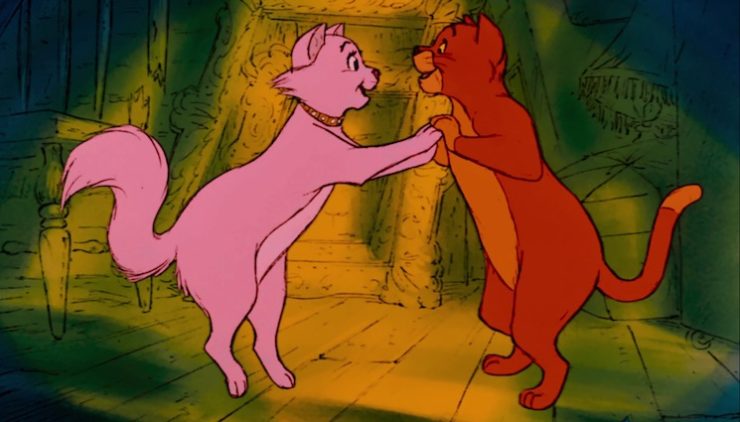After Walt Disney’s death, a pallor hung over the Disney animation studios, with animators and executives alike unsure of whether they should continue creating animated films—or even if they could. Almost all of the greatest Disney animated films had benefited from Walt Disney’s close—occasionally too close—supervision. The least successful film, The Sword in the Stone, was the film that he’d had the least involvement with. And although the last film he’d supervised, The Jungle Book, had been a hit, the animation studio was still on a restricted budget, with no chance of recreating the lavish animation of the prewar films, or even the simpler beauty of something like Lady and the Tramp.
On the other hand, the animated films continued to bring in money for Disney during every theatrical re-release, animation was proving to be increasingly popular on television, and the company had built its reputation on animation. Disney decided to go ahead with another animated film. But they also decided to play it very safe, choosing The Aristocats—a project originally planned for television, not film, but which had the advantage of having the seal of Walt Disney’s approval.
The Aristocats was a safe choice in other ways as well, rehashing, as it did, elements from the most popular recent Disney films. An incomplete list includes a well to do, gently bred pet meeting a scruffy yet charming animal from the other side of the tracks, just as in Lady and the Tramp; animals sporting distinctive ethnic accents gathering to sing a song, just as—again—in Lady and the Tramp; adorable little animals needing to be saved from a greedy evildoer, just as in One Hundred and One Dalmatians; adorable baby animals then trekking wearily across the countryside, led by parental figures and helped out by various animals, again just as in Dalmatians; Phil Harris voicing a scruffy, carefree animal who learns to be responsible and brave, in between singing swinging songs, just as in The Jungle Book, an adorable mouse (somewhat distractingly voiced by Disney standby Sterling Holloway in the same voice he used for Pooh), just as in Cinderella and the company’s mascot, and far more. It’s virtually a paint-by-numbers mix of some of Disney’s greatest hits, which undoubtedly helps account for its later popularity.
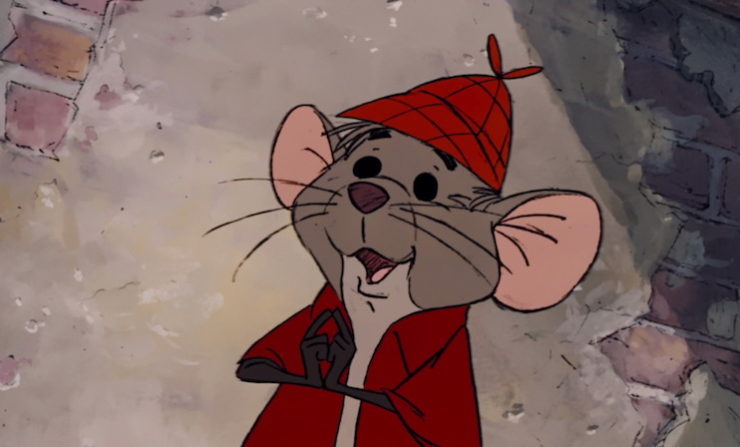
The plot, too, adds to the feeling of safety. Insipid villain Edgar, after all, is arguably one of the most inept, and least terrifying of all Disney villains. Indeed, he isn’t even a villain until he overhears his employer’s plans to leave her wealth to a cat and three kittens instead of to a more deserving object, like, say, him. It’s not a completely unsympathetic viewpoint. Once turned sorta evil, his villainous plans, such as they aren’t, focus on giving cats some drugged cream, putting them in a bag, and dumping them outside the city. Oh, sure, as Edgar makes sure to tell us, the newspapers have praised his catnapping skills, but as evil plans go, this lacks something. Most notably, any plans to kill the cats, or even send them more than what seems to be about a day’s walk from their Paris home.
Sure, it’s relatively unlikely that the cats will find their way back on their own—indeed, as it turns out, they need help—but not at all unlikely that Edgar’s employer, Madame Adelaide, will post a LOST CATS notice with a description of Duchess and her three kittens. Given her obvious wealth, she could even hire detectives to go out kitten hunting for her. Plus, I’m also not sure why Edgar doesn’t wait for her to die first before trying to get rid of the cats—what if she just turns around and adopts another cat and leaves her fortune to that one? And, for that matter, as Edgar himself notes, even the kittens are not that likely to live that long. Patience is the best plan here, Edgar, is what I’m saying. In any case, the most that Edgar manages to do in this film is deprive a wealthy woman of her cats for a few days, and force the cats to do more walking and less napping than they, as cats, would prefer to do.
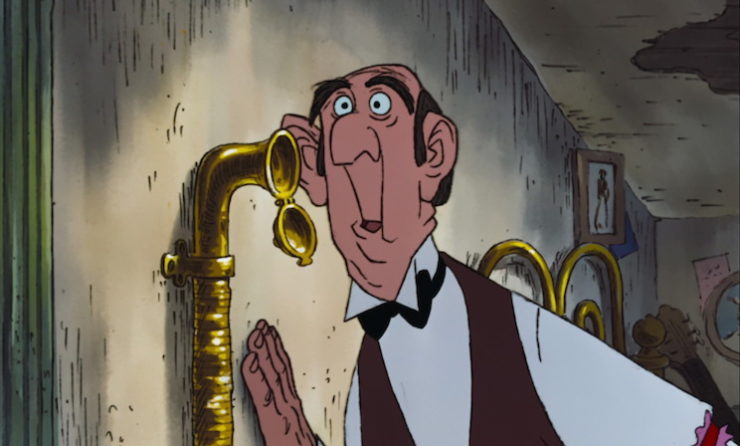
Sure, none of this is exactly nice, but it’s also nothing compared to other Disney villains. And also, not all that threatening.
Nor is anything else in the film particularly threatening either. A sequence where Thomas O’Malley is almost drowning happens at such a leisurely pace that two British twin sister geese are able to have a conversation about it. When Roquefort the mouse heads off to get help from the Scat Cats, they give him plenty of time to identify himself and O’Malley—time he takes, reducing the tension. And by the time Edgar and the cats have their final confrontation—well, I mentioned that Edgar is not exactly all that threatening. In their first confrontation, Edgar could only take down the sheltered kittens and the aristocratic cat by drugging them and their neighborly cats. In the second confrontation, kittens and cat are awake. Sure, the film did take the time to establish that Duchess believes that fighting and biting are not very nice, and therefore she has refused to let her children practice these skills. But the the film also established that the kittens have spent plenty of time fighting. They should be able to defeat the wimpy Edgar with just a scratch or two, without needing a dramatic alley cat, mouse, and horse rescue. That rescue is good for a couple of laughs—I like the moment when a Parisian gentlemen takes a hard look at his wine bottle after watching a pack of alley cats run down the street, chased by a mouse—but suspenseful, it isn’t.
About the only suspenseful moment comes in an earlier scene, when the kittens see a, gasp, oncoming train, forcing all of them—and Duchess and O’Malley—to cower under a shaking bridge as the train rushes by. It would be even more suspenseful if it hadn’t left me thinking that the river must have other bridges perfectly safe for cats to march across, if needed, and if I hadn’t been distracted by a few pencil marks left by the animators—an unfortunate side effect of the Xerography process.
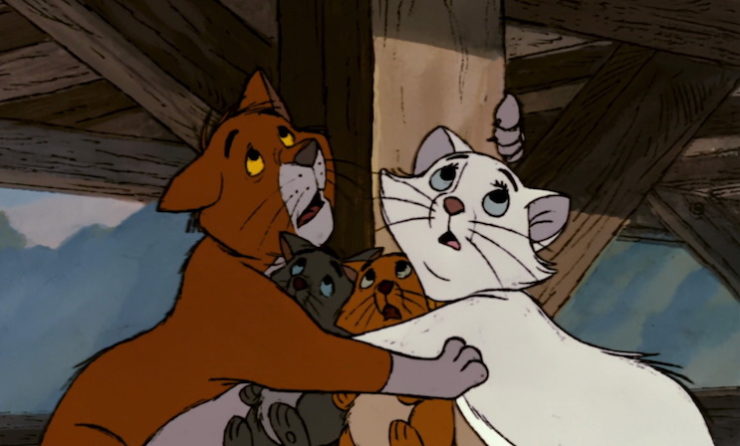
Speaking of which, the animation in The Aristocats does tend to be a bit cleaner than the animation in The Jungle Book and 101 Dalmatians. By this time, the Xerography process had been slightly refined, and the pencil marks are not quite as apparent as they were in the earlier films—although this is not a film that’s helped by a big screen, or the ability to pause the film so that you can point specifically to said pencil marks. Many of the backgrounds are lovely—I particularly adore the outside of Madame Adelaide’s house. But The Aristocats also features something that was an increasingly common feature of the Disney films between Sleeping Beauty and The Black Cauldron: recycled and traced animation. Several drawings, especially of the kittens, get repeated, and other bits were copied from 101 Dalmatians (the other reason why the two films get compared so frequently—they don’t just have fairly similar plots; they have literally the same art in some scenes.)
Where The Aristocats does shine is in two songs: the title song, sung by legendary French singer Maurice Chevalier, brought out of retirement for this film, in the final song he would ever record, and the film’s signature song, “Ev’rybody Wants to Be a Cat.” The second could have been one of the greatest songs in the Disney canon. Unfortunately, it’s marred by two elements: the decision to have kitten Marie contribute some painfully off key notes, and the racist lyrics sung by Sung Gon, the, sigh, Chinese member of the Scat Cat gang, voiced by white guy Paul Winchell, making this a hellish combination of racism and having a white guy voice an Asian role. It’s not just outdated, and racist, but painful to listen to.
It’s a pity, because the other voices include Phil Harris in top form, along with Scatman Crothers, who would later greatly descend from this to voice Jazz in the 1980s The Transformers cartoon.
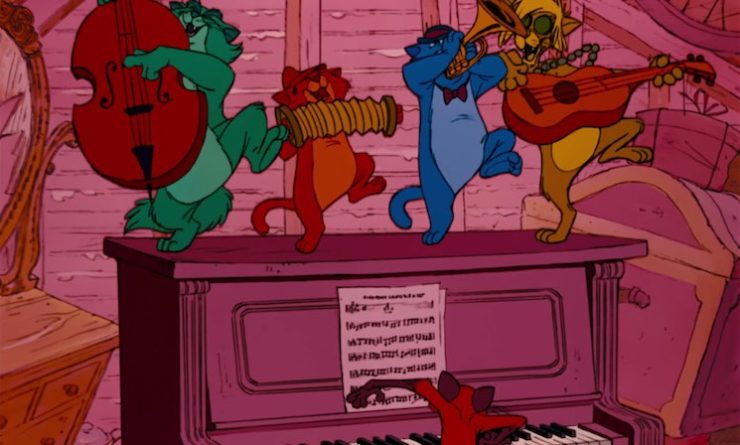
The song was too popular—and otherwise, too catchy—for Disney to bury it completely, however racist the lyrics. An edited version, eliminating the Sung Gon and Marie sections, can be heard in the theme parks; a version without Sung Gon, but with Marie, is included in several later Disney albums. Disney’s later authorized recordings of this song, including the recent Charles Perry cover, also eliminate the Sung Gon section, and several enterprising YouTubers have created rather less authorized but also considerably less offensive versions.
In its defense, “Ev’rybody Wants to Be a Cat” does provide some much needed energy to the film, which otherwise tends to proceed at a leisurely pace, when it proceeds at all. The film frequently, for instance, pauses for things like kitten lessons, or the two geese meeting their drunken uncle—drunk because the French chef wanted to cook him in wine, a joke that probably would have worked better had the uncle not still had most of his feathers left, or conversations between dogs, or moments when little mouse Roquefort chats with the horse about the failed search for the kittens. Often cute, but rarely more than that.
This is also true of the romance between Duchess and O’Malley. Oh, it has its cute moments, and the appropriate romantic notes of a full moon and approving side comments from little Marie, but it lacks the depth of the parallel relationship in Lady and the Tramp. For one, in the earlier film, Lady is deliberately giving up a life with Tramp that she admits sounds delightful in order to return to a house with two malicious cats, where she’s been muzzled—all to ensure that someone is around to protect the baby from a rat that she’s seen on the premises. It’s the right move, the noble move, especially given the doubts that Lady has had since the baby’s arrival. In contrast, Duchess and her kittens are giving up a life with O’Malley in order to return to a home where they’ve been so indulged, the kittens even get to practice art and music, and to inherit a very large fortune. Yes, Duchess points out that Madame will miss them very much, but heading back to a life of luxury to comfort a wealthy old woman is not quite the same as heading back to protect a baby from a rat.
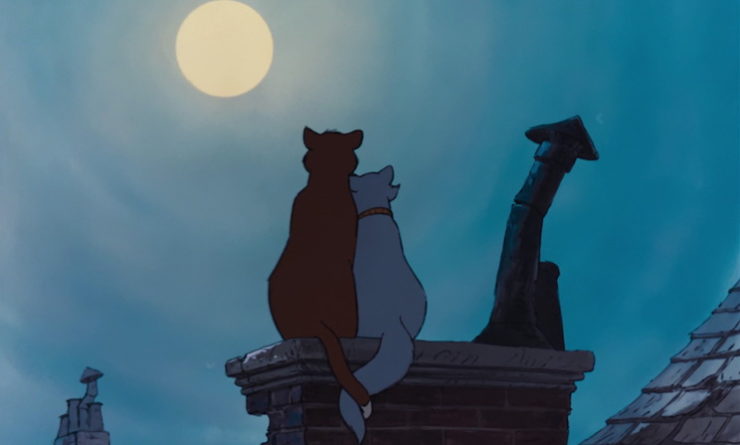
Things are also shallower with Tramp and O’Malley. Comments made by Tramp about human babies strongly suggest that he was kicked out of an earlier home: he’s made himself the friendly stray of several households to prevent a repeat of this, but still has a genuine—earned—distrust of humans. O’Malley does not. He does, admittedly, have a group of alley cat friends that he wants to hang out with, but as an obstacle between him and Duchess, this, too, lacks something. It’s fairly clear why Tramp thinks he can’t join Lady—he doesn’t have that necessary license that separates pets from strays, and Lady has not been thrilled, to put it mildly, to hear the various hints about the other dogs in his past. It’s less clear why O’Malley can’t saunter around to visit Duchess and the kittens on a regular basis, and their “breakup” feels even shallower than their romance, which is saying something.
On the other hand, O’Malley—with the help of the geese—does guide Duchess and the kittens back to their home, and does help rescue them when Edgar attempts to send them away a second time, so he deserves some reward. And by seeing the good in him, Duchess is able to reform him. So there’s that.
Plus, the kittens want a father, and Duchess is really a beautiful—and aristocratic—cat.
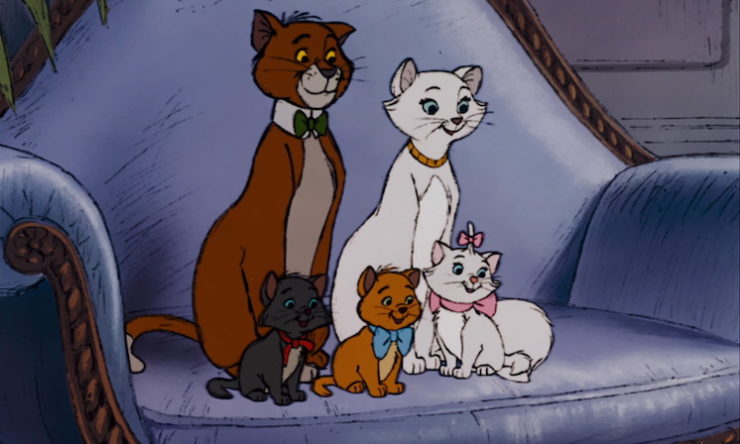
Despite its flaws, The Aristocats did decently at the box office and in subsequent rereleases. The film was never quite popular enough to inspire a ride at Disney parks, and at least so far, Disney has not rushed to provide the expected direct-to-video sequel, for which I can only be grateful. Still, the film remains a sentimental favorite for many Disney fans, and the company continues to sell plush toy versions of Duchess and her kittens, as well as clothing bearing various quotes from the film, and The Aristocats Disney Trading Pins (check Hollywood Studios and Animal Kingdom).
If nothing close to the glory days of Disney animation under Walt, it was hardly a complete failure, either. Far worse was to come.
Which brings us to Robin Hood, coming up next.
Mari Ness lives in central Florida.










